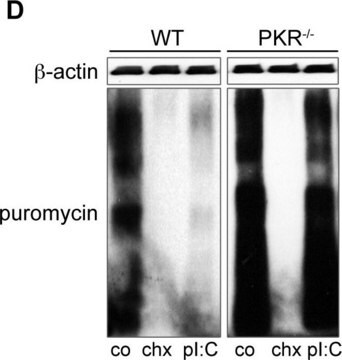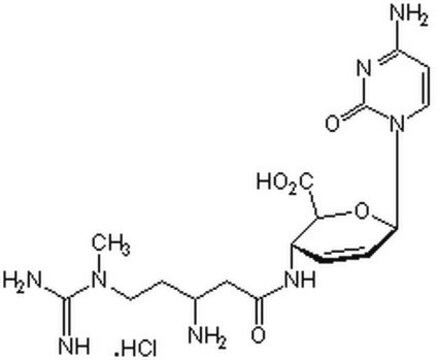P9620
Puromycin -dihydrochlorid
Ready Made Solution, from Streptomyces alboniger, 10 mg/mL in H2O, suitable for cell culture
Synonym(e):
3′-(L-α-Amino-p-methoxyhydrocinnamamido)-3′-deoxy-N,N-dimethyladenosine dihydrochloride, Stylomycin dihydrochloride
About This Item
Empfohlene Produkte
Biologische Quelle
Streptomyces alboniger
Qualitätsniveau
Typ
for cell culture
Assay
>98% (HPLC)
Form
solution
Lagerbedingungen
(Store in cool place. Keep container tightly closed in a dry and well -ventilated place. )
Konzentration
10 mg/mL in H2O
Methode(n)
cell culture | mammalian: suitable
Farbe
colorless to yellow
Löslichkeit
H2O: soluble 10 mg/mL
Wirkungsspektrum von Antibiotika
Gram-positive bacteria
neoplastics
parasites
Wirkungsweise
protein synthesis | interferes
Versandbedingung
wet ice
Lagertemp.
−20°C
SMILES String
Cl.Cl.COc1ccc(C[C@H](N)C(=O)N[C@H]2[C@@H](O)[C@@H](O[C@@H]2CO)n3cnc4c(ncnc34)N(C)C)cc1
InChI
1S/C22H29N7O5.2ClH/c1-28(2)19-17-20(25-10-24-19)29(11-26-17)22-18(31)16(15(9-30)34-22)27-21(32)14(23)8-12-4-6-13(33-3)7-5-12;;/h4-7,10-11,14-16,18,22,30-31H,8-9,23H2,1-3H3,(H,27,32);2*1H/t14-,15+,16+,18+,22+;;/m0../s1
InChIKey
MKSVFGKWZLUTTO-FZFAUISWSA-N
Allgemeine Beschreibung
Aufgrund seiner strukturelle Ähnlichkeit mit dem aminosäuretragenden Ende der tRNA kann Puromycin während der Proteinsynthese in das Ribosom eintreten, an die entstehende Polypeptidkette binden und die Kettenverlängerung stoppen. Puromycin wird häufig in Zellkulturen verwendet und dient als selektiver Wirkstoff für Zellen, die mit einem Gen transformiert wurden, das eine Resistenz gegen Puromycin verleiht.
Anwendung
Biochem./physiol. Wirkung
Widerstandsmechanismus: Puromycin-Acetyltransferase ist ein wirkungsvolles Resistenzgen.
Antimikrobielles Spektrum: Dieses Produkt ist aktiv gegen grampositive Mikroorganismen, weniger aktiv gegen säurefeste Bazillen und schwächer aktiv gegen gramnegative Mikroorganismen. Puromycin kann das Wachstum von Bakterien, Protozoen, Algen und Säugerzellen verhindern und wirkt rasch (Abtötung von 99 % aller Zellen innerhalb von 2 Tagen).
Leistungsmerkmale und Vorteile
- Hochwertiges Antibiotikum für verschiedene Forschungsanwendungen
- Antibiotikum und Proteinsynthesehemmer
- Wirksam gegen prokaryotische und eukaryotische Zellen
- Hemmt die Proteinsynthese durch Störung der RNA-Funktion
- Wird häufig als selektiver Wirkstoff in der zellbiologischen Forschung verwendet
Angaben zur Herstellung
Sonstige Hinweise
Vergleichbares Produkt
Lagerklassenschlüssel
10 - Combustible liquids
WGK
WGK 2
Flammpunkt (°F)
Not applicable
Flammpunkt (°C)
Not applicable
Persönliche Schutzausrüstung
Eyeshields, Faceshields, Gloves, multi-purpose combination respirator cartridge (US)
Analysenzertifikate (COA)
Suchen Sie nach Analysenzertifikate (COA), indem Sie die Lot-/Chargennummer des Produkts eingeben. Lot- und Chargennummern sind auf dem Produktetikett hinter den Wörtern ‘Lot’ oder ‘Batch’ (Lot oder Charge) zu finden.
Besitzen Sie dieses Produkt bereits?
In der Dokumentenbibliothek finden Sie die Dokumentation zu den Produkten, die Sie kürzlich erworben haben.
Kunden haben sich ebenfalls angesehen
Artikel
The introduction of small interfering RNAs (siRNAs) into cultured cells provides a fast and efficient means of knocking down gene expression and has allowed siRNAs to quickly become a ubiquitous tool in molecular biology.
MISSION® Target ID Library for Human miRNA Target Identification and Discovery;
Introduction of small interfering RNAs (siRNAs) into cultured cells provides a fast and efficient means of knocking down gene expression and has allowed siRNAs to quickly become a ubiquitous tool in molecular biology.
Our lentiviral vector systems are developed with enhanced safety features. Numerous precautions are in place in the design of our lentiviruses to prevent replication. Good handling practices are a must.
Protokolle
This detailed procedure allows you to transduce Mouse Embryonic Fibroblasts (MEF) using MISSION ExpressMag Super Magnetic Kit.
You are not alone designing successful CRISPR, RNAi, and ORF experiments. Sigma-Aldrich was the first company to commercially offer lentivirus versions of targeted genome modification technologies and has the expertise and commitment to support new generations of scientists.
FACS (Fluorescence-Activated Cell Sorting) provides a method for sorting a mixed population of cells into two or more groups, one cell at a time, based on the specific light scattering and fluorescence of each cell. This method provides fast, objective, and quantitative recording of fluorescent signals from individual cells.
Unser Team von Wissenschaftlern verfügt über Erfahrung in allen Forschungsbereichen einschließlich Life Science, Materialwissenschaften, chemischer Synthese, Chromatographie, Analytik und vielen mehr..
Setzen Sie sich mit dem technischen Dienst in Verbindung.










